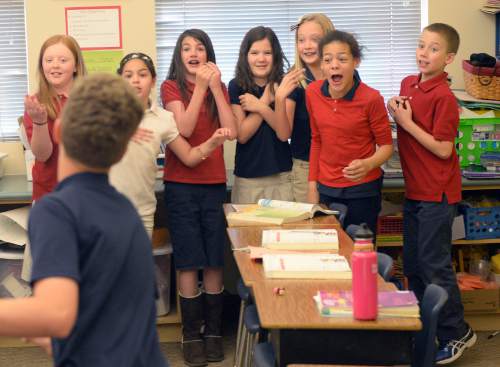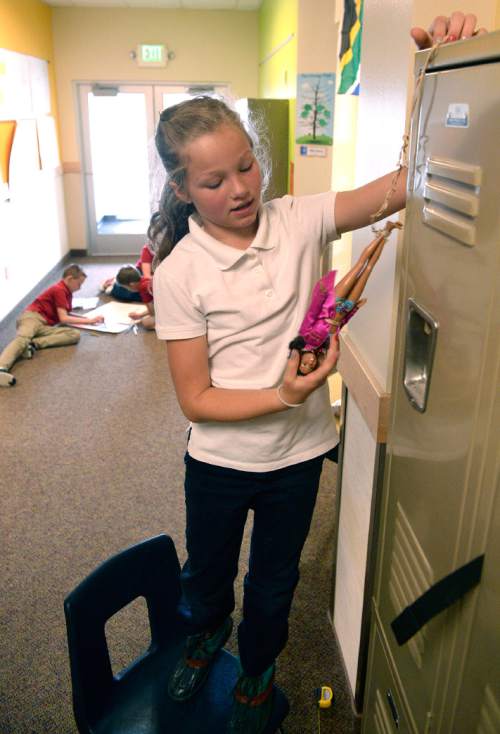This is an archived article that was published on sltrib.com in 2016, and information in the article may be outdated. It is provided only for personal research purposes and may not be reprinted.
Utah spends $683 less per pupil every year educating charter school students than their traditional school district peers, according to a report released Wednesday by the public-policy group Utah Foundation.
That funding gap will narrow by roughly $200 next year as the state implements SB38, directing an additional $20 million to charter schools, which are public schools that operate independently of Utah's 41 school districts.
But while the funding levels between school types are unequal, it is unclear whether they are also inequitable, said Shawn Teigen, research director at the Utah Foundation.
The question of funding equity, he said, is complicated by charter school advantages, like a younger and more affluent student body, streamlined course and activity offerings, and freedom from school transportation laws that require districts to bus students from remote areas of the state.
"Per pupil, charter school students are definitely getting a smaller amount of funding," Teigen said. "But it's hard to say whether or not they are at some kind of disadvantage, because the systems are inherently different."
The Utah Foundation report — commissioned, in part, by the state Charter School Board — attempts to weigh charter school advantages and disadvantages against the funding that different schools receive.
If the goal is equity, or fairness, and not equality, Teigen said, it's possible that goal has already been achieved, will be achieved with SB38, or will swing in the charter schools' favor as the state continues to alter funding calculations.
"Equity in many things is a lofty goal, including funding equity in Utah publicly funded schools," the report states. "However, it is unlikely to occur in a way that will satisfy all parties."
Utah opened the door to charter schools in 1998, and in the past two decades, the alternative schools have grown to enroll one out of every 10 public-education students in the state. But that growth has failed to capture a demographically representative student population, Teigen said.
According to the report, charter schools on average have fewer students with disabilities (12 percent versus 12.5 percent), non-English speakers (4.2 percent versus 8.9 percent), students from low-income households (31 percent versus 39 percent) and students of color (19.8 percent versus 23.2) than Utah's traditional district schools.
"It is a trickier thing to educate a more diverse population," Teigen said. "[Charters] are having a narrower subset of people they are educating. They don't need to offer quite the breadth of things."
And Teigen said one of the biggest advantages for charters is that their optional nature allows for a self-selecting community.
"You've got parents who are, on average, inherently more interested in or have more time to think about [education]," he said.
But charter schools are also disadvantaged, according to the report, because they lack the ability to levy property taxes and are dependent on Utah's income tax revenue.
And the state's use of per-pupil funding calculations leads to new charter schools launching without revenue streams in place, requiring startup grants or loans to open the doors.
Charter School Board Chairman Howard Headlee said school districts receive the state's AAA bond rating, while new charters are individually rated AA or BBB-.
That means charter schools are forced to divert funds for interest payments that could otherwise be spent in the classroom, he said.
"I don't think there's any risk that [charters] have swung ahead," he said. "Anyone who would suggest that charters are somehow at an advantageous position is talking from a political point of view and not a technical point of view."
Headlee also argued that excluding charters from transportation laws, and the state funds that go with them, limits the ability to recruit and attract diverse families to school-choice alternatives.
"Charters can't just be a choice for children whose families have two cars," he said.
Teigen said some differences between charter and school district funding should remain because charters were intended to exist separately from the traditional school system.
"If you try to make them totally equitable and equal," he said, "you lose the reason and the rationale for having charter schools in the first place."
He also said the question of equity distracts from the broader funding challenges of Utah's public school system.
With or without charters, Teigen said, Utah would still rank 51st among U.S. states and Washington, D.C., for the money it spends educating each public-school student.
"It's kind of a silly question," Teigen said. "Should we be comparing and having a competition between these two [systems], or should we be increasing the size of the pie for everybody?"
Twitter: @bjaminwood

























